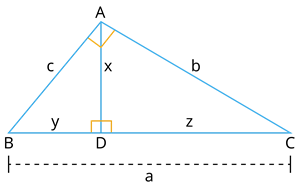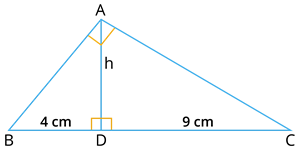PDF chapter test TRY NOW
Illustration:
Consider a triangle ABC right angled at A with its hypotenuse BC at its base.
Draw an altitude to the triangle as follows:

Two smaller right triangles ABD and ACD are obtained.
Now, all the three triangles ABC, ADB and ADC are similar.
Based on this similarity, the following theorem is obtained.
Statement:
If an altitude is drawn to the hypotenuse of an right angled triangle, then:
(i) The two triangles are similar to the given triangle and also to each other.
That is, \Delta ABC \sim \Delta ADB \sim \Delta ADC.
(ii) x^2 = yz
(iii) b^2 = za and c^2 = ya where a = y + z
Example:
From the figure, find the altitude h.

Solution:
By the statement (ii) of the Altitude-on-Hypotenuse theorem, the altitude is computed as follows:
h^2 = BD \times DC
h^2 = 4 \times 9
h^2 = 36
\Rightarrow h = \sqrt{36}
= 6
Therefore, the measure of the altitude is 6 cm.
